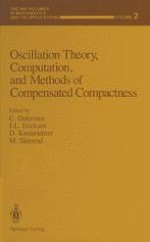1986 | Book
Oscillation Theory, Computation, and Methods of Compensated Compactness
Editors: Constantine Dafermos, J. L. Ericksen, David Kinderlehrer, Marshall Slemrod
Publisher: Springer New York
Book Series : The IMA Volumes in Mathematics and its Applications
Included in: Professional Book Archive
